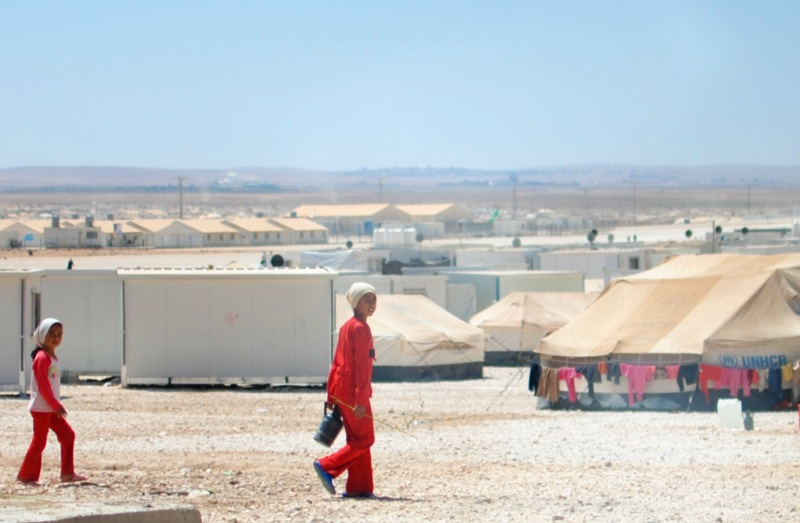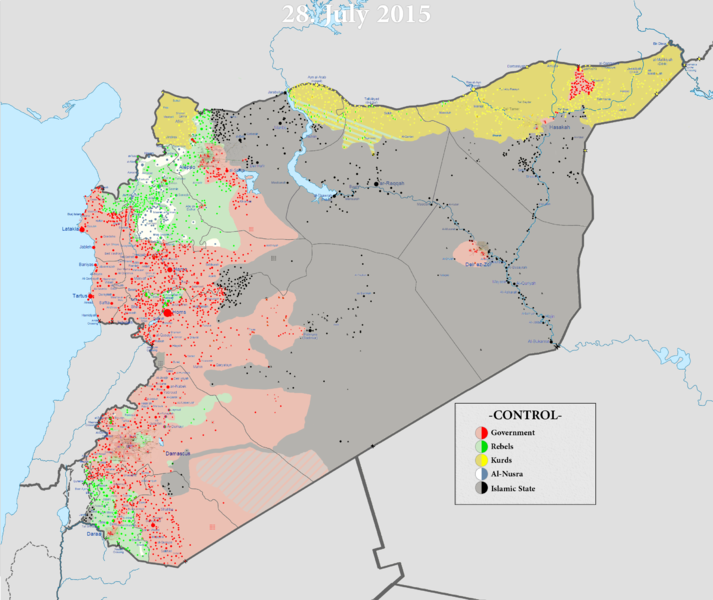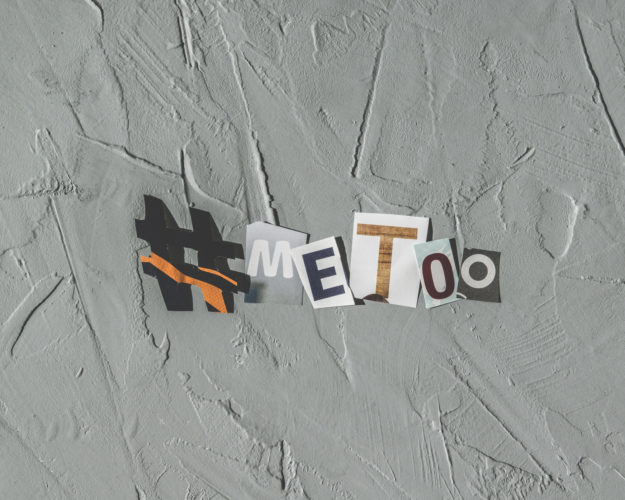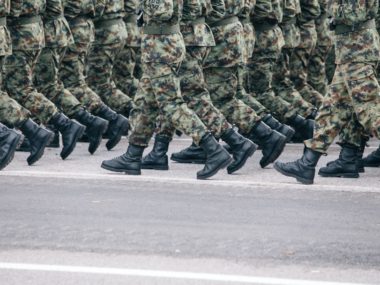A few quick and random thoughts on my recent trip interviewing refugees along the Syrian-Jordanian border and in the notorious Za’atari camp.

First, the refugees were not the worst off in Syria, which means those internally displaced could pose greater challenges in the long run. Those who got out either had familial connections across the border or the means to bribe their way past enough checkpoints to make it into Jordan. Most I spoke to were middle-income Syrians from Daraa province, itself an area long associated as a smugglers’ route in the region.
Second, the refugees I interviewed are stubborn, and reminded me some of American twenty-somethings who refuse to buy health insurance — most never thought they’d be in this position. A recent International Crisis Group report hints that once a region falls to the rebels, locals then flee since they know they will be targeted indiscriminately by the regime. I found that Syrians refused to flee even when they could see bombings in the distance. It was only when their own block or home was targeted that they left. Moreover, the longer the fighting raged on, the more ‘invincible’ they become and feel they can just wait out the storm. I found little evidence that they became refugees in anticipation of government attacks.

Third, Jordan is not their first choice. Most refugees have hopped around from home to home, often moving as many as a dozen times before ultimately making the decision to try to cross the border. Most would prefer to live in Syria, but found it too dangerous, or were worried about the safety of their children. For a few, it was the petty corruption that made their everyday lives unbearable. Others complained that Sunnis were being targeted by indiscriminate attacks.
Fourth, the Syrians I spoke to thought their time in Jordan would be short-lived. They all believed the US would intervene as it did in Libya and they would go home in a few months. Once reality set in, they began to get more settled in but also began harping about the poor conditions of camps in Jordan. A few were resentful because they said the Iraqi and Lebanese refugees they hosted from previous conflicts enjoyed better hospitality (something Syrians are known for). The most common complaints were poor health and education services, bland food, and unsanitary conditions in Za’atari. Those that can hope to be “bailed out” by a Jordanian family and prefer to live outside of camps (which is where the large majority of them reside).

Fifth, as bad as Za’atari is, it’s not as bad as camps I’ve visited elsewhere in Sri Lanka or the Philippines. Actually the UNHCR team there is doing an exceptional job, and the team members I interviewed came off as very dedicated to the effort (they are grossly understaffed and underfunded). They literally built the camp in nine days last summer and in less than a year its population mushroomed to around 125,000 (the number is constantly in flux, as refugees return to Syria, or are bailed out), making it Jordan’s fourth largest city. “I remember when it was just a few camels and Bedouins,” Aoife McDonnell, an Irish UN worker, told me.
Indeed, Za’atari is less a refugee camp than a “temporary city,” as UN officials refer to it. Each of its 25,000 households is given a tent or trailer. In the beginning, the refugees were resentful of the high-mindedness of the UN staff, which corralled them into neat and tidy rows to impose a kind of legibility to the camp. I examined a map from 2012 that showed tidy rows of caravans in a legible and uniform grid, like a Midwest city. But refugees kept moving their trailers to cluster next to kin or friends, as one with means might do in any metropolis. The trailers began to look less like perpendicular rows of orderliness and more like improvised cul-de-sacs and spaghetti-like clusters. Several refugees combined their tents or trailers with a lean-to, to replicate the Ottoman merchant houses native to Syria. In other words, in an attempt to impose a formulaic, high-modernist legibility to the camp, the refugees silently resisted by remaking the camp into a desert version of Jane Jacobs’ Greenwich Village.
Not every effort in Za’atari felt like something out of James Scott’s Seeing Like A State. UN workers joked about starting a KickStarter campaign to raise monies for bicycles (there is no transportation in the camp and it takes one woman I interviewed over an hour each way to walk her daughter to school). An effort was also underway when I recently visited Za’atari to decentralize the camp, to make it more orderly and improve communication between district leaders and councils and the UN administers. The camp is currently being rezoned into twelve districts to better distribute resources, patrol the camp, and improve dialogue between the administrators and refugees. There is a plan to push refugees from congregating in the overcrowded parts of Districts 1 and 2 and into Districts 11 and 12 (imagine an inverted clock but with one and two in the top-left corner and 11 and 12 in the top right), which are wider open but far from everything (refugees from Damascus, who tend to be more urbane and wealthier, tend to settle in these areas). These areas are where one can find greatest access to the shops and camp’s main entrance, along with the tiny hut if one loses their child. On Fridays, the dusty driveway that feeds into the entrance streams with Syrian families from nearby Mafraq who haul in goods from the outside.

Sixth, no matter how good intentioned, the camp remains a humanitarian disaster in the making. Refugees vandalize washrooms and kitchens, cut down electricity poles, and steal diapers. On a list of priorities scribbled on a dry-erase board in the UNHCR conference room, diaper replenishment – cost: $5 million – tops the list. Even plans to top the dusty grounds with gravel – which cost millions – was not without complications. Younger refugees began pelting the UN vehicles with stones. There is concern among officials about opening a new camp in al-Azraq in the east of Jordan because the dirt there is coarser, and the rocks, if thrown, could do more damage to their vehicles.
Refugees have even pilfered the prefab caravans, which cost $18,000 apiece, are made in Jordan, and resemble a scaled-down version of a FEMA trailer: a khaki-colored caravan sheathed in vinyl brown siding, with a few slits of light peeking in from tiny windows. They are poorly insulated, which in a desert climate – it drops below zero at night – also contributes to the health crisis in the camp. The first thing most refugees I spoke to purchased upon arrival was not food or water but wool blankets.
The health needs of refugees keep rising. Thirteen babies are born in the camp every day. In the premature baby ward in Mafraq, the surrounding province, 12 of the 16 babies on a recent visit were Syrian (only two were Jordanian). Because of poor sanitation, viruses are common in the camp. Refugees have begun constructing their own makeshift toilets, which look like tiny moats carved in the sand under their tents and trailers.
The area around Za’atari to the north is known as a popular smuggling route for cigarettes and sex workers, fuel, and drugs like ecstasy. There are militia elements within the camp that came to make a quick buck, as well as recruit young men into the Free Syrian Army, the umbrella opposition groups fighting Assad. Each district of the camp has a leader. “Behind that leader is another leader,” said Iris Blom of UNHCR. “There are a lot of networks. The informal economy is flourishing.” There is an anything-goes ethos to the camp that administrators and many refugees I spoke to find unsettling. “Everything is possible in Za’atari” Jalaa Ahmed, 35, a former café owner from Daraa who now resides in Irbid, told me. “You can propose to any daughter or any girl [in Za’atari] and you’ll marry her very fast.”
Seventh, Syria’s refugees are among the most entrepreneurial I’ve ever seen. Commerce within the camp has flourished, a result of the refugees’ do-it-yourself ethos more than UNHCR’s top-down central planning. Syrians were unhappy with the Jordanian food, so they smuggled in their own spices, stoves, and style of cooking from across the border. Women formed community kitchens. “They didn’t appreciate the nasty rice, yucky stew, plastic-looking dates, or cheap bread,” said Kate Washington of CARE International. “They were like ‘just give me a stove, onion and garlic.'” Aid workers now say the best falafel in the region is found in Za’atari. “We’ve never seen anyone as innovative, resourceful, and industrious,” said Jonathan Carpenter of the UN’s World Food Program. “In a way they’re inspirational.” Along the main shopping drag, nicknamed “the Champs Elysees” one can find not one but three bridal shops, as well as a medley of metal kiosks outfitted from rusty corrugated boxes that sell everything from jewelry to satellite televisions to solar panels, shisha lounges, barber shops, internet cafes, a billiards hall, and at least one bank. I saw one refugee selling teacups recycled from old tomato cans.
Eighth, idleness remains a problem. There is little work available. Many refugees pass the time by playing video games or watching television. They stand on each other’s shoulders at the highest point in the middle of the camp – an area called “Mount Syria” – and can receive a cellular signal from Syria. Za’atari has its own Facebook page. But most of the news travels by word of mouth. The camp is only a few miles from the border. When news arrived of the chemical attacks outside Damascus, the camp went quiet. “They felt powerless,” said Blom. “They wanted their own way of mourning.” The attacks were announced over a loudspeaker, shops were closed, and the UNHCR canceled all outside visits by journalists. Many younger men fled the camp to return to Syria and take up arms.
Finally, every refugee I spoke to favors US intervention. Every refugee aid worker I met, however, was against the idea of US military involvement in Syria.
All photos by the author.








31 comments
This is excellent reporting – hard to read – overwhelming – but everyone should read it. Thanks for this important contribution.
wat naruto is more important
Thank you for this insightful post.
The issue in Syria are breaking my heart. ?
Very well captured and analyzed. It’s interesting how many things are in common among refugees across the globe – things like unwillingness to leave their homeland (hoping that things will get back to normal soon). But it’s good to see the hope and impression of a positive impact from a US intervention. Very enlightening blog! Thanks for sharing!
If not for American money many would actually speak their minds!
This is so sad, no one wants to leave their homeland, settling down in an unfamiliar environment is always very difficult, i really feel for them, thanks for sharing
Very interesting. I like the combination of overview, statistics, and human details. I’m intrigued by your observations about the surprising extent of entrepreneurship among Syrian refugees at Za’atari.
“We’ve never seen anyone as innovative, resourceful, and industrious,” said Jonathan Carpenter of the UN’s World Food Program.” I’m wondering about those other refugees elsewhere in the world who are so much less “innovative, resourceful, and industrious” — what makes the difference? I’d be interested in the author’s opinion about this and whether the UN workers had additional insight on the subject.
Thanks for the informative reporting.
My friend is currently in Jordan. She’s studying the Palestinian/Israeli conflict. Seeing the refugee camps of the fleeing Syrians has devastated her heart. This stuff NEEDS to be covered. Thanks for sharing!
I couldn”t care less. We have much too much to concern us in the US just to survive to even begin caring about these places. Tragic. Awful. Sad. Maybe will help you get noticed by someone for a job… but nothing can be done, or should be done. Since when was there not violence in the world and how is bothering these people going to help. Besides they hate us and it is time we get the message.
Because Hitler, Stalin and others made sure it was OUR problem and consequently destroyed human lives around the world. Unless we care about others, then the rights of free people are jeopardized.
Honestly couldn’t bring myself to read after seeing Syria and Camp go together. But I love the images, tells a not so “sad” story. Even the family that lost their dad, still have a look of hope in their eyes. Glad to be stumbling on your blog today, I’ll probably look into paying a bit more attention to the unsettling news of war and US military involvement in Middle Eastern parts of the world.
Even though your photos seems to depict a not too “bad” situation still war/rebellion always tell of horrible stories…I feel blessed somehow that despite pockets of rebellion in my own country, I have none in my own family or circle who get to experience first-hand all these horrors…
It really pains to hear the suffering caused by wars. Thanks for sharing.
You see for as bad as things were they are even worse now. Moreover, if there is no coherent policy towards Syria, then this sad tragedy will continue and those with hope will have to re-examine their plight realistically.
Reblogged this on citychic123 and commented:
i disagree to what is happening and i think it is really good of you to start a blog which happens to be this topic
Though this is hardly a tantamount comparison, it reminds me somewhat of how Americans reacted in the last five, six years as the foreclosure crisis reached a crescendo and neighborhoods began emptying out, one by one. In the midst of it personally, residents in blighted areas seemed indifferent, or blind, to the atmospheric disruptions when whole families vanished overnight, often leaving half of their belongings behind with no warning.
Americans continued to blunder through their daily grinds with blinders, never mentioning the pages filling their local newspapers filled with property auctions due to foreclosures. In the smallest communities, 20+ foreclosures ever month made a notable dent – created ghost towns.
Yet no one paid any mind, either afraid of the same fate befallen them, or not believing anything like it could ever happen “to them.” The infrastructure of the U.S. has eroded along with the collective morale, yet the insouciance lingered – grumbling or gossiping about others not being responsible enough and over-extending themselves, while they, too, maxed out credit cards, equity lines, and refused to take heed of the signs all around them.
The Middle Class was targeted and because it had never worn such a bullseye on its back, it allowed the expulsion to occur without a fight. Ninety-nine percent, according to stats, never contested foreclosures – simply walked away.
Syrian refugees, as any refugees, are far away, ancient, to American citizens, even after the catastrophes exploding around them daily – on their doorsteps and in their taken-for-granted institutions. The war within the U.S. has been overlooked, since hiding in plain view is the easiest way to hide from an American these days.
These are the kinds of insights to which Americans should be more privy, as most citizens are under-exposed to anything but their own creature comforts and the occasional discomfort of something too obvious and big to ignore.
However, again I should underscore that I in no way consider U.S. citizens suffering in such a way – displaced and roaming within a Diaspora with no endgame in sight. Therein lies the rub, I think.
That’s the problem with third world countries, their people are too simple to see the other side of the western propaganda. Syrians went against their president, even though he was making a clear move in the right direction. Political freedom in a starved economy means nothing. Bashar Al-Assad was making good progress with the Syrian economy. Maybe that’s what scared the west and caused this mess. It’s a shame that innocent people have to suffer because of political games.
I am not with Obama on this but please do not blame the whole mess on us or even me. I had nothing to do with it.
I couldn’t sat it better my self
You mentioned as fourth that many hope for US intervention like in Libya to return safely into their homeland afterwards. It’s interesting as nowadays many Libyans are in Syria to fight with them again Assad. There’s just a tiny difference as Libyans stayed in Libya and were facing the cruelty until Gadaffi was dead. They love their country and if you ask them if flee would have been an option instead of being wounded they will answer with no. They fought hard and lost many loved ones throughout this time but they stayed. Sorry to say that but Syrians are getting out of Syria and hope that others make their country worth returning. Can this be the way?
Thought-provoking piece – I especially I liked how you touched on the exploitation of female refugees. I’d be interested to learn more community reactions on the sensitive topic of gender-based violence in the camp?
Gender violence is so vast that it is almost overlooked and it shouldn’t.
http://www.apotekfarma.net